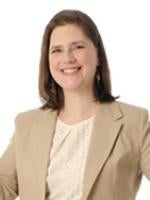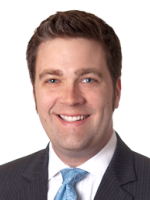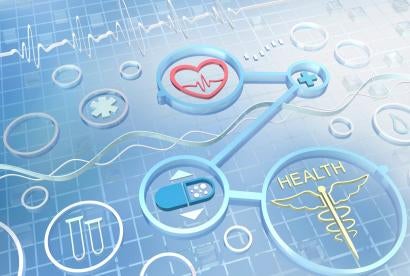Digital healthcare, the confluence of digital technology with medical and other biological fields, has become an ever-increasing presence in our daily lives. Ideas that seemed nearly impossible just a few years ago (such as wearable sensors that provide personalized feedback, smart prosthetics, health and fitness apps, software-driven diagnostics, and therapeutics, to name a few) are now commonplace. To preserve their place in the market, digital healthcare innovators must decide whether to patent their technology, keep their technology as a trade secret, or release technology with the hope that the first mover advantage turns them into industry leaders.
Adding to the mix for decision-makers, recent guidance from the U.S. Supreme Court has left many in the industry wondering whether their software-based tools are even eligible for a patent. In an attempt to clarify its position on this issue, the United States Patent and Trademark Office (USPTO) issued Interim Guidance for subject matter eligibility under 35 U.S.C. § 101 on December 15, 2014. With regards to software, these new guidelines largely follow the previous interim guidelines issued on June 25, 2014, in view of the recent Supreme Court decision in Alice v. CLS Bank, with some additional details.1 These recent developments at the USPTO should be considered by decision-makers weighing their options on when and how patent protection is sought. The following article discusses the practical effect of this new guidance with particular emphasis on aspects of the guidance that are relevant to digital healthcare.
Summary of the Guidance
The new guidance instructs examiners to apply a “two-step” eligibility analysis of the patent’s claims, as articulated by the Supreme Court in Alice. Importantly, the Guidance also confirms that “[e]very claim must be examined individually, based on the particular elements recited therein, and should not be judged to automatically stand or fall with similar claims in an application.” The eligibility analysis consists of a “step 1” to determine whether a claim is directed to “a process, machine, manufacture or composition of matter.”2 If the claim is not directed to one of these statutory subjects, then the analysis need go no further because the claim is not eligible. But if an examiner determines that the claim falls within one of the statutory categories, then the examiner must perform “step 2” of the eligibility analysis. This second step will be most relevant to digital healthcare technologies.
Step 2 of the analysis itself comprises two parts. First, in step 2A, the patent examiner must determine whether the claims are directed to a judicially recognized exception to § 101 – i.e., “a law of nature, a natural phenomenon, or an abstract idea.”3 If a claim is not directed to a judicially recognized exception, then the claim is eligible under §101.
If, however, the examiner determines that a claim is directed to a judicially recognized exception, then she must perform step 2B of the eligibility analysis. Namely, the examiner must determine whether the claims recite “additional elements that amount to significantly more than the judicial exception.”
Analysis of Guidance for Digital Healthcare
Step 2A
As noted above, Step 2A requires an examiner to determine whether a claim is directed to a judicially recognized exception to § 101. The area of digital healthcare may implicate any of the judicially recognized exceptions – indeed, some digital healthcare devices and technologies may implicate several or all of the judicially recognized exceptions. Accordingly, this step will be of particular importance to digital healthcare inventions.
Products of nature
Courts have found claims reciting the following subjects as directed to products of nature:
• isolated DNA (Myriad);
• a correlation that is the consequence of how a certain compound is metabolized by the body (Mayo);
• electromagnetism to transmit signals (Morse); and
• the chemical principle underlying the union between fatty elements and water (Tilghman).
The “products of nature” exception may be implicated by, for instance, wearable or implantable sensors, diagnostics, and therapeutics.
Abstract ideas
In accordance with Alice, the Interim Guidance explains that fundamental economic practices, certain methods of organizing human activities, an idea ‘of itself,’ and mathematical relationships/formulas are abstract ideas. Citing previous cases, the Interim Guidance provides examiners with specific examples of abstract ideas:
• mitigating settlement risk (Alice);
• hedging (Bilski);
• creating a contractual relationship (buySAFE);
• using advertising as an exchange of currency (Ultramercial);
• processing information through a clearinghouse (Dealertrack);
• comparing new and stored information and using rules to identify options (SmartGene), (vii) using categories to organize, store and transmit information (Cyberfone);
• organizing information through mathematical correlations (Digitech);
• managing a game of bingo (Planet Bingo);
• the Arrhenius equation for calculating the cure time of rubber (Diehr);
• a formula for updating alarm limits (Flook);
• a mathematical formula relating to standing wave phenomena (Mackay Radio); and
• a mathematical procedure for converting one form of numerical representation to another (Benson).
The “abstract ideas” exception may be implicated by virtually any digital healthcare technology – particularly those that are software-driven.
Step 2B
If, in step 2A, the examiner finds that a claim is not directed to a judicially recognized exception, then Part 2B need not be addressed. But, if the examiner determines that a claim is directed to a judicially recognized exception, then the step 2B analysis must be performed. The Guidance provides examples of limitations that may be enough to qualify as “significantly more” when recited in a claim. These examples include:
• improvements to another technology or technical field;
• improvements to the functioning of the computer itself;
• applying the abstract idea with, or by use of, a particular machine;
• effecting a transformation or reduction of a particular article to a different state or thing;
• adding a specific limitation other than what is well-understood, routine and conventional in the field, or adding unconventional steps that confine the claim to a particular useful application; and
• other meaningful limitations beyond generally linking the use of the abstract idea to a particular technological environment.
These examples are consistent with the recent Federal Circuit Decision in DDR Holdings, LLC. v. Hotels.com (“DDR”).4
Limitations that do not qualify as “significantly more” include:
• adding the words “apply it” (or an equivalent) with the abstract idea, or mere instructions to implement an abstract idea on a computer;
• simply appending well-understood, routine and conventional activities previously known to the industry, specified at a high level of generality, to the abstract idea, e.g., a claim to an abstract idea requiring no more than a generic computer to perform generic computer functions that are well-understood, routine and conventional activities previously known to the industry;
• adding insignificant extrasolution activity to the abstract idea, e.g., mere data gathering in conjunction with the abstract idea; and
• generally linking the use of the abstract idea to a particular technological environment or field of use.
2-Step Analysis Not Always Necessary
According to the Interim Guidance, examiners do not need to perform the complete 2-part analysis when eligibility is self-evident. A full analysis may not be needed where the claims clearly do not preempt the abstract idea in such a manner that others cannot practice it. For instance the interim guidelines note that a claim directed to a complex manufactured industrial product or process that recites meaningful limitations along with an abstract idea may sufficiently limit its practical application so that a full eligibility analysis is not needed. As an example, a robotic arm assembly having a control system that operates using certain mathematical relationships is not an attempt to tie up use of the mathematical relationships and would not require the examiner to perform the full 2-step analysis to determine eligibility. Similarly, the guidelines explain that a claim directed to an artificial hip prosthesis coated with a naturally occurring mineral is not an attempt to “tie up the mineral” and would, therefore, also not require the 2-step analysis.
Conclusions
There are significant open questions concerning how the guidelines will be applied in the area of digital healthcare. For instance, would the same rationale that the guidelines applied to the “robotic arm,” above, also apply to medical devices? Additionally, where will the USPTO draw the “significantly more” line in step 2B? Answers to these questions and more will only become clear after a sufficient number of cases have been examined under the new guidelines.
The Interim Guidance became effective on December 16, 2014 and is not legally binding. The USPTO is seeking public comments on this Interim Guidance along with additional suggestions on claim examples by March 15, 2015.
1 Alice Corp. Pty. Ltd. v. CLS Bank Int’l, 573 U.S. __, 134 S. Ct. 2347 (2014)
2 These are the statutory categories defined in 35 U.S.C. § 101.
3 See, e.g., Diamond v. Chakrabarty, 447 U.S. 303, 309 (1980)
4 DDR Holdings, LLC. v. Hotels.com, L.P., __ F.3d __ (Fed. Cir. Dec. 5, 2014)





 i
i

